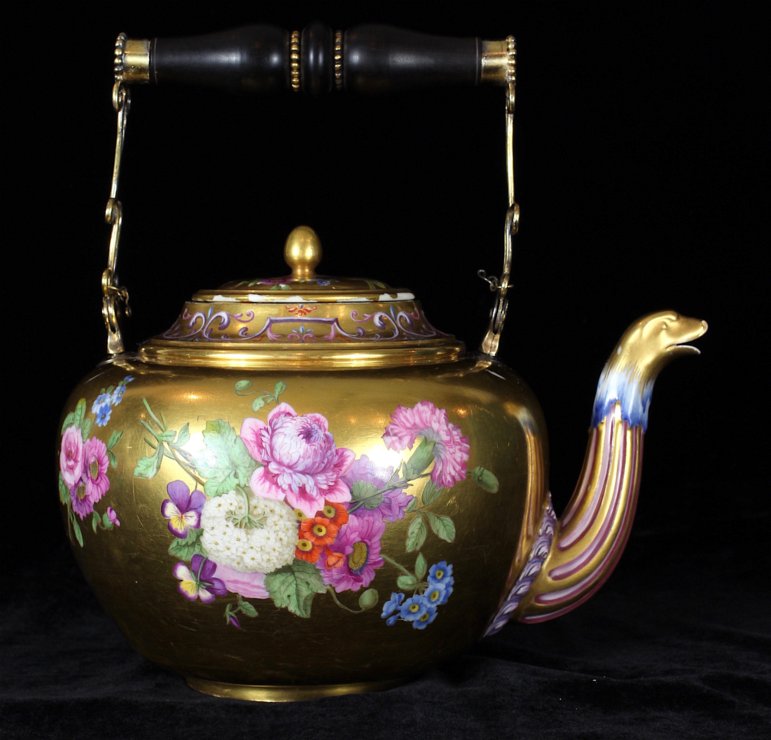Dalva Brothers Antiques, Antique Furniture, New YorkFrench 18th century furniture, clocks, lighting, paintings, porcelain, sculpture and tapestries |
| Rare Sèvres teapot (bouillotte or bouillotte chine) by Philippe Parpette. The unusual teapot or kettle, perhaps originally used for hot water, is decorated with exceptionally well painted flowers on a brilliantly burnished gold ground. The fluted spout terminates in a dolphin or dragon head with an open mouth, painted red on the interior, above a blue and white motif suggesting water dripping from the creature’s neck. The spout is joined to the body by a collar composed of an exquisite band of purple, blue and white curved feathers. The tapered neck is decorated with polychrome scrolls. The top, with a finial, is decorated with three floral sprays. The separate turned ebony handle, designed to insulate the hand from the heat of the vessel, has vermeil wire attachments; unlike all other recorded versions, which are lyre-form, the wires here are shaped as interlaced crossed “L”-s, the royal emblem. [Lacking the chain that retained the top. Tiny bits of enamel missing from the flowers on the top. Wear to gilded edges. Small areas of wear on the teapot body due to handle rubbing.] In 1779, Marie-Antoinette ordered one bouillotte for the very large price of 360 livres and Louis XVI ordered two, one for 312 livres and the second for 288 livres. One of these probably corresponds to the bouillotte made by Parpette in 1779 that must be the present bouillotte, which is cited by Peters, “Artists’ Ledgers, Vj’1, Parpette, 19.1.1779, bouillotte fleurs sur fond d’or” (“bouillotte flowers on gold ground”). (Peters, David: Sèvres Plates and Services of the 18th Century; Hertfordshire, 2005. Volume I, page 65.) A covered trembleuse in Pavlovsk Palace, owned by Maria Fedorovna, has the same unusual decoration, the same date mark and the same painter’s mark and almost certainly was made together with this bouillotte. (See Pavlovsk: The Collections; Paris 1993, Page 149, fig.18.) The grand duke Paul of Russia and his wife, Maria Fedorovna, made a fourteen-month grand tour trip to Western Europe commencing in 1781. In 1782, they arrived in Paris and under the pseudonym “comte et comtesse du Nord” visited all the right places including the Manufactory of Sèvres where they purchased porcelain with the enormous value of 112,626 livres, including at least three déjeuners (tea or coffee services.) . Factory records for June 1782 note Philippe Parpette working for the most exalted clients, and being been paid 48 livres each for the jewelling of two cups with portraits of the comte and comtesse du Nord, émaillées richement, (“richly enameled”) and in July 1782, the same sum for the two cups and saucers with portraits of Louis XVI and Marie-Antoinette. In addition to their purchases, they also received sumptuous gifts from Marie-Antoinette and Louis XVI, including the magnificent huge blue amphora-form mounted vases and the legendary toilet service in the Pavlovsk Palace. A later bowl with the same unusual decoration, also from the Binney collection, is now in the Sèvres Museum (23.191). Made at the very end of the 18th century, it has the cipher for “République Française” and the mark “Sevres”. It is signed by Parpette and the gilder André-Joseph La France. It was probably ordered from Sèvres as a replacement piece for a broken waste bowl from a service. (Information kindly supplied by John Whitehead.) Dated – bb - 1779 Painter – PP – Philippe Parpette. Ex collection: Hector Binney Literature: Dawson, Aileen: French Porcelain, A Catalogue of the British Museum Collection; London, 1994. Page 144. Munger, Jeffrey: “A Bouillotte in the Museum of Fine Arts, Boston” in Mélanges en souvenir d’Elisalex d’Albis, Paris, 1999. Page 103, footnote f; page 105, and footnote 16; page 109, footnote 33. Roth, Linda H. and Le Corbeiller, Clare: French Eighteenth-Century Porcelain at the Wadsworth Atheneum; Wadsworth Atheneum, 2000. Page 207, footnote 17. Published Examples: [List largely from Dawson and Munger] 1) USA, New York, Dalva Brothers, Inc., gold ground, painted with flowers by Parpette, 1779. (Formerly Sotheby's, 5 December 1989, Hector Binney sale, Lot 146.) 2) France, Sèvres, Musée national de Céramique, inv. MNCS 23260, illus. Brunet, Marcelle and Préaud, Tamara, Sèvres, des origines à nos jours, Fribourg, 1978, p. XLIX, p. 109 3) Denmark, Copenhagen, David Collection, inv. 24/1978, illus. Eriksen, Svend, The David Collection, French Porcelain, Copenhagen, 1980, no. 62. 4) Switzerland, Geneva, Sotheby's, 14 November 1989, Lot 3, wine-red ground, painted with flowers by Bulidon, 1782. 5) USA, Boston, Museum of Fine Arts, inv. 1975. 658, dated 1779, painted by Castel with an exotic bird in a Chinoiserie landscape on a white ground. 6) USA, Hartford, Conn., Wadsworth Atheneum, roses in pink on a white ground, date-letter effaced, inv. 1917.1156. 7) N. Ikodinovic & Co., S.C., exhibited at International Ceramics Fair and Seminar Ltd., London, June 1990, illus. Handbook, p. 65, dated 1779, Chinoiserie figures in gold and enamels on a salmon-pink ground, no painter's mark. (Now in a private collection, USA.) 8) Chicago, Art institute of Chicago: inv.517a-b, brown ground with gilded “Etruscan figures. 9) England, London, British Museum: inv. Franks 385, brown ground with Chinoiserie figures in two tones of gold and silver by Dieu. 10) France, Paris, Christie’s, 7 November 2012, Lot 45, yellow ground with scattered polychrome roses with a central frieze of polychrome flowers enclosed in a gilded border. (Now in a private collection, USA.) |
||
| Height (ins.): 7.4 (18.8 cm.) Length/Width (ins.): 7.25 (18.4 cm.) Depth (ins.): 6 (15.2 cm.) | ||
| Origin: France, 1779 Period: Louis XVI | ||
|
|
||
|
||
| << Previous Page | ||




